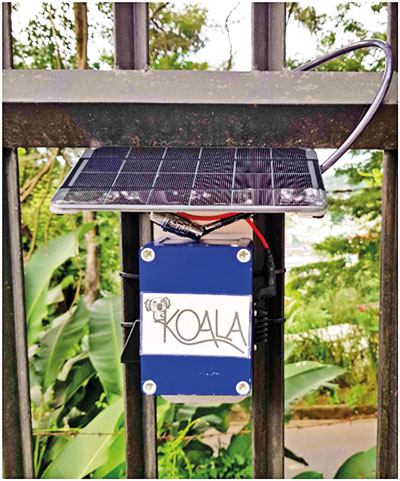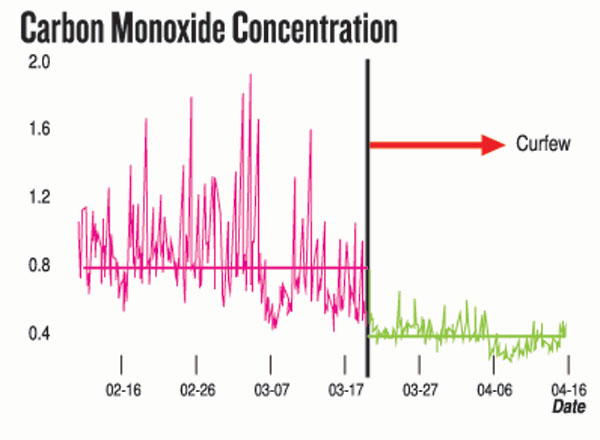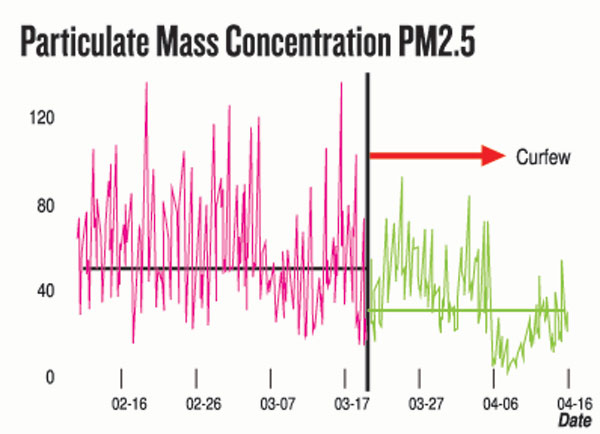News
Effect of the curfew on air quality in Colombo and Kandy

Air Quality Monitor installed in Kandy
The COVID-19 situation has affected normal activities all over the world. There are fewer motor vehicles on the roads and many factories remain shut, giving rise to significant decreases in airborne pollution. For example, Beijing has reported visible blue skies after many years. In some regions in Northern India, residents have been able to see the Himalayas from afar for the very first time. Residents in Colombo have been enjoying spectacular views of Adam’s Peak and the central hills. So, by how much have the pollution levels in Sri Lanka decreased during the recent curfew period?
Air pollution occurs in the form of gases and small particles. The particle pollution in the atmosphere is generally expressed as PM2.5, which is the mass per unit volume of particulate matter on particles that are smaller than 2.5 micrometre in diameter. Normally, the PM2.5 level in the city of Colombo is around 60 micrograms per cubic metre. Typically, around 80% of the particles in urban environments originate from motor vehicle emissions, and over 99% of these particles are smaller than 2.5 micrometres. When inhaled by humans, these tiny particles are capable of passing through the respiratory tract to the alveoli (gas transferring sacs in the lungs). Extensive research conducted globally have conclusively shown that these particles are linked to increased mortality and morbidity, with growing evidence for an increased risk of respiratory and cardiovascular diseases.

Air Quality Monitor installed in Kandy
Carbon Monoxide (CO) is another pollutant originating from motor vehicles. CO levels in Colombo are typically close to 1.0 part per million (ppm). Exposure to high levels of CO has been linked to headache, nausea and vomiting, blurred vision and dizziness.
The KOALA (Knowing Our Ambient Local Air quality) monitor was designed and constructed by the International Laboratory for Air Quality and Health at the Queensland University of Technology in Brisbane, Australia. It is a stand-alone solar-operated device with the capacity to monitor PM2.5 and CO levels in the atmosphere in real time and transmit the data to an in-cloud database through the cellular network.
In early February, two of these units were installed in Colombo – on Havelock Road near the Police Park, and on Green Path in Kollupitiya. Several units were also operational in Kandy – at the National Institute of Fundamental Studies (IFS) and one at Trinity College.
The accompanying charts show the hourly average PM2.5 and CO concentrations in Colombo between February 9 and April 15. The curfew was enforced on March 20 – shown by the vertical broken line. The two horizontal lines indicate the average pollution levels before and after this date. Similar trends were observed in Kandy.
The table presents a summary of the results obtained over approximately a month before the curfew was introduced until after approximately one month during the period of the curfew. We see that the 24-hour average PM2.5 and CO levels in Colombo dropped by 34% and 49%, respectively, from the period before the curfew was introduced to after. If we consider the corresponding values during the daytime only, these two numbers go up to 37% and 52%, respectively. This small increase is expected because motor vehicle traffic has a somewhat greater influence on the atmosphere during the daylight hours. It is also expected that the decrease due to the curfew is greater for CO than for PM2.5 because a larger fraction of the CO in the urban atmosphere comes from motor vehicles than does PM2.5.
Similarly, the 24-hour average PM2.5 and CO levels in Kandy dropped by 25% and 36%, respectively. The decrease in Kandy was not as great as in Colombo, probably because the pollution level in Colombo is generally higher.
These results give a good idea of how much of our air pollution is produced by human activities.
(Dr Rohan Jayaratne – Queensland University of Technology, Australia. Dr Gayan Bowatte and Mahesh Senarathna – University of Peradeniya.)
The authors wish to thank the National Science Foundation (NSF) Sri Lanka, Centre for Air pollution energy and health Research (CAR) and Mobitel Sri Lanka for funding the project.
| Hourly pollution levels before and during the curfew periods | |

|



